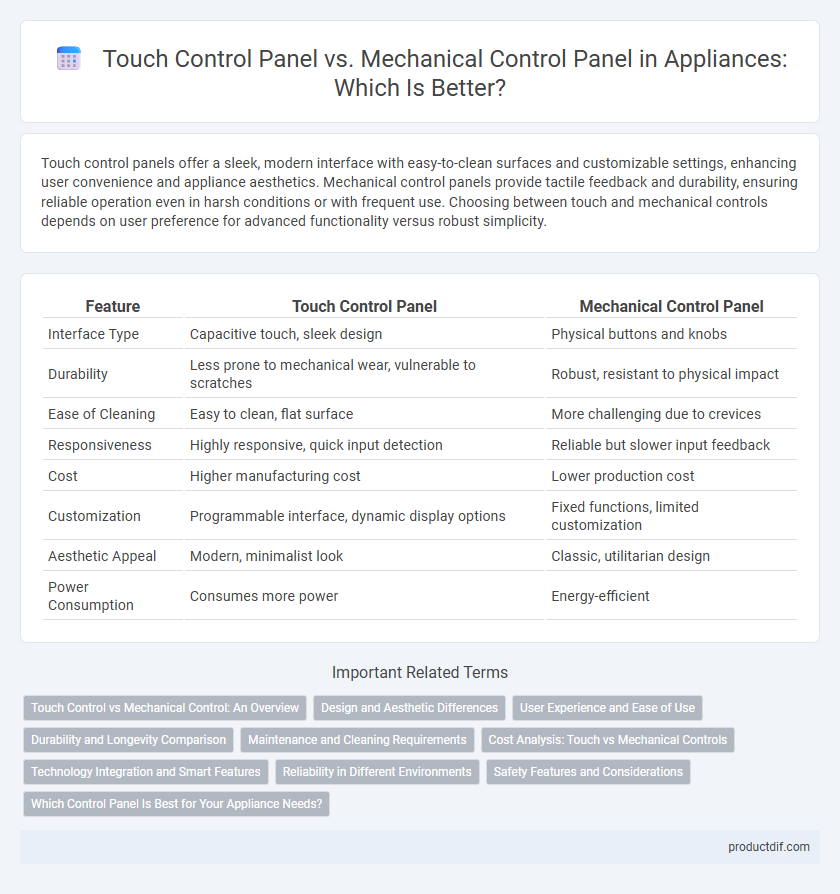Touch control panels offer a sleek, modern interface with easy-to-clean surfaces and customizable settings, enhancing user convenience and appliance aesthetics. Mechanical control panels provide tactile feedback and durability, ensuring reliable operation even in harsh conditions or with frequent use. Choosing between touch and mechanical controls depends on user preference for advanced functionality versus robust simplicity.
Table of Comparison
| Feature | Touch Control Panel | Mechanical Control Panel |
|---|---|---|
| Interface Type | Capacitive touch, sleek design | Physical buttons and knobs |
| Durability | Less prone to mechanical wear, vulnerable to scratches | Robust, resistant to physical impact |
| Ease of Cleaning | Easy to clean, flat surface | More challenging due to crevices |
| Responsiveness | Highly responsive, quick input detection | Reliable but slower input feedback |
| Cost | Higher manufacturing cost | Lower production cost |
| Customization | Programmable interface, dynamic display options | Fixed functions, limited customization |
| Aesthetic Appeal | Modern, minimalist look | Classic, utilitarian design |
| Power Consumption | Consumes more power | Energy-efficient |
Touch Control vs Mechanical Control: An Overview
Touch control panels offer a sleek, modern interface with enhanced ease of use and quick responsiveness, making appliance operation more intuitive compared to mechanical control panels. Mechanical control panels rely on physical buttons and knobs that provide tactile feedback but may wear out over time and lack the precision of touch controls. Advances in capacitive touch technology ensure durability and accuracy, positioning touch control panels as the preferred choice in contemporary appliances.
Design and Aesthetic Differences
Touch control panels offer sleek, modern designs with smooth glass surfaces that seamlessly integrate into appliance exteriors, enhancing contemporary aesthetics. Mechanical control panels feature tactile knobs and buttons that provide a traditional, industrial look, appealing to users who prefer visible and physical controls. The choice between the two affects both the appliance's visual appeal and user interaction experience.
User Experience and Ease of Use
Touch control panels provide a seamless and modern user experience with intuitive gesture-based interactions, offering quick access to settings and a sleek design that enhances appliance aesthetics. Mechanical control panels deliver tactile feedback through physical buttons or dials, which many users find reassuring for precise adjustments and reliability, especially in environments with wet or greasy hands. Both control types influence ease of use, with touch panels favoring customization and minimal effort, while mechanical panels prioritize durability and straightforward operation.
Durability and Longevity Comparison
Touch control panels in appliances typically offer greater durability due to the absence of moving parts, reducing wear and potential mechanical failure over time. Mechanical control panels rely on physical buttons and switches that can degrade or break with frequent use, leading to reduced longevity. Consumer reports and industry tests consistently show touch interfaces maintain functionality longer under rigorous daily operation.
Maintenance and Cleaning Requirements
Touch control panels require minimal maintenance due to their smooth, flat surfaces that resist dirt and grime buildup, making cleaning straightforward with a damp cloth and mild detergent. Mechanical control panels, featuring buttons and knobs, demand more frequent and detailed cleaning to remove debris trapped in crevices and ensure functionality. Over time, mechanical components are prone to wear and may require repairs or replacements, whereas touch panels generally offer greater durability and easier upkeep.
Cost Analysis: Touch vs Mechanical Controls
Touch control panels typically incur higher upfront costs due to advanced technology and sensitive components, while mechanical control panels are generally more affordable with simpler parts. Maintenance expenses for touch controls can be elevated because repairs often require specialized service or component replacement, in contrast to the easier and cheaper fixes for mechanical switches. Long-term cost considerations also include durability and user experience, where touch panels may reduce wear but risk costly failures, whereas mechanical panels might wear out faster but are cost-effective to replace.
Technology Integration and Smart Features
Touch control panels in appliances offer seamless technology integration with smart home systems, enabling features like voice commands, customizable settings, and remote access via mobile apps. Mechanical control panels rely on physical knobs and buttons, limiting connectivity and smart functionality but providing tactile feedback and simplicity in operation. Advanced touch interfaces support sensors and adaptive controls that enhance user experience and energy efficiency, making them ideal for modern smart appliances.
Reliability in Different Environments
Touch control panels offer higher reliability in humid or dusty environments due to their sealed, flat surfaces that prevent moisture and debris infiltration. Mechanical control panels, with exposed moving parts, are more prone to wear, corrosion, and malfunction under harsh conditions. Industries requiring durable and low-maintenance interfaces often prefer touch controls for consistent performance across diverse environmental challenges.
Safety Features and Considerations
Touch control panels enhance appliance safety by minimizing physical wear and eliminating exposed moving parts, reducing the risk of electrical shocks and mechanical failures. Mechanical control panels, though durable and straightforward, often present pinch points and can accumulate dirt or moisture, increasing potential hazards. Manufacturers prioritize touch controls for built-in safety features such as locked settings and moisture detection to prevent accidents and ensure safer operation.
Which Control Panel Is Best for Your Appliance Needs?
Touch control panels offer sleek designs, seamless interfaces, and easy cleaning, ideal for modern appliances seeking intuitive operation. Mechanical control panels provide tactile feedback, durability, and reliability, making them suitable for users prioritizing precision and simple maintenance. Choosing the best control panel depends on your preference for advanced functionality versus traditional robustness in your appliance.
Touch control panel vs Mechanical control panel Infographic

 productdif.com
productdif.com